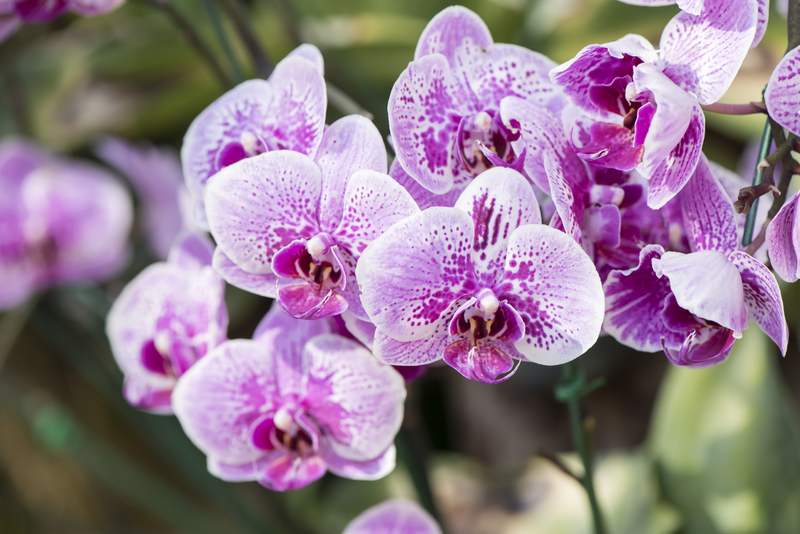Thriving Orchids: The Ultimate Care Guide
Posted on 05/06/2025
Thriving Orchids: The Ultimate Care Guide
Orchids are among the most captivating and diverse flowering plants in the world, prized for their exquisite blooms and unique beauty. However, achieving healthy, thriving orchids can be a challenge even for experienced gardeners. This comprehensive guide will teach you everything you need to know about orchid care, ensuring your plants not only survive but flourish and bloom year after year. Whether you're a novice or a seasoned grower, you'll find practical, SEO-optimized, and easy-to-follow advice here. Let's cultivate your ultimate orchid oasis!
Understanding Orchids: A Brief Overview
Before delving into the essential care requirements, it's important to understand what sets orchids apart from other houseplants. With over 25,000 species and as many as 100,000 hybrids, orchids are one of the largest plant families on Earth. Their adaptability is unmatched, but most commonly grown varieties share similar needs. Highly popular types include:
- Phalaenopsis (Moth Orchid) - Ideal for beginners due to its resilience and long-lasting blooms.
- Cattleya (Corsage Orchid) - Known for its vibrant, fragrant flowers.
- Dendrobium - Features long canes and copious, delicate blossoms.
- Oncidium (Dancing Lady Orchid) - Recognizable by its frilly, fluttering petals.
- Paphiopedilum (Lady's Slipper Orchid) - Distinctive pouches resemble slippers.
While these species vary in appearance, their care fundamentals overlap. Understanding the core needs of orchids is the key to success.

Orchid Care Basics: What Makes Orchids Thrive?
1. Light: The Foundation of Thriving Orchids
Proper light is fundamental for healthy orchids. Most orchids need bright, indirect light. Direct sunlight, particularly midday sun, can scorch leaves, while insufficient light results in poor growth and lack of blooms.
- Phalaenopsis: Filtered morning light near east-facing windows is ideal.
- Cattleya and Dendrobium: Prefer slightly brighter conditions, such as shaded south or west exposure.
- Use sheer curtains to diffuse strong sunlight.
- Yellow leaves usually mean too much light; dark green, too little.
- Artificial grow lights (fluorescent or LED) can supplement natural light, especially in winter.
2. Watering Orchids: Less is More
Watering is where most orchid owners struggle. Orchids root systems thrive in humid, airy environments--not soggy soil. The key is to let the potting mix dry slightly between waterings.
- Water once a week during the growing season (spring and summer), less in winter.
- Use tepid, distilled, or rainwater to minimize mineral buildup.
- Avoid overwatering; roots should appear white (dry) or green (moist) and plump.
- Water in the morning to allow leaves to dry by nightfall (prevents rot).
- Never let pots stand in water--good drainage is crucial!
3. Humidity: Mimicking the Orchid's Natural Habitat
Most orchids grown indoors, especially Phalaenopsis, prefer humidity between 40-60%. Low humidity can hinder flowering and cause shriveled pseudobulbs.
- Group plants together or place pots atop a pebble tray with water.
- Use a humidity tray or room humidifier during dry winter months.
- Mist leaves lightly (not flowers!) in the morning for a quick boost.
- Ensure adequate air circulation to prevent fungal issues.
4. Temperature: Creating Optimal Growing Conditions
Orchids flourish within certain temperature ranges:
- Phalaenopsis: 65-80?F (18-27?C) days; 60-65?F (16-18?C) nights.
- Cattleya & Dendrobium: slightly warmer days, cool nights encourage blooming.
- Avoid dramatic fluctuations and cold drafts.
- Short drops in night temperature can stimulate flowering in many orchid types.
5. Air Circulation: Essential for Healthy Orchids
Giving your orchid plenty of fresh air is vital for thriving growth and preventing disease.
- Use a gentle fan in stuffy rooms or during humid weather.
- Avoid positioning orchids directly in the path of air conditioners or heat vents.
- Open windows occasionally for natural airflow.
6. The Right Potting Mix: Anchoring Orchid Roots
Standard soil is never suitable for orchids. Their roots must breathe, and normal potting soil stays too wet. Always choose a specialized orchid mix, which typically includes:
- Bark chips (fir, cedar, redwood)
- Sphagnum moss
- Perlite, charcoal, or coco husk for added drainage
- Pumice or lava rock for Cattleya and other epiphytes
Repotting every 1-2 years is crucial, as bark decomposes and loses its structure. Always repot after flowering unless roots are growing actively.
Essential Orchid Maintenance for Ongoing Success
Fertilizing Orchids: The "Weakly, Weekly" Rule
For vivid leaves and abundant blooms, orchids require feeding--but little goes a long way. Too much fertilizer will burn delicate roots.
- Apply a balanced, water-soluble orchid fertilizer (20-20-20 or similar) at quarter strength every two weeks when growing actively.
- Reduce or stop feeding during dormancy or winter rest.
- Once a month, flush the potting mix with clear water to remove salt buildup.
- Bloom boosters with extra phosphorus can promote flowering in mature plants.
Repotting Thriving Orchids
Repotting is necessary to:
- Refresh decomposed media
- Promote healthy root growth
- Allow for plant expansion
Signs it's time to repot:
- Roots creeping over the pot edge
- Bark is soft or smells musty
- Poor drainage or visible root rot
- Gently remove the orchid from its pot; shake off loose mix.
- Trim dead or mushy roots with sterilized scissors.
- Place the plant in a slightly larger pot with fresh, moistened orchid mix.
- Water sparingly for a week and resume normal care when new growth appears.
Encouraging Blooms: Get Your Orchids Flowering Again
One of the most anticipated moments of orchid care is seeing those spectacular flowers reappear. Here's how to encourage reblooming:
- Provide a brief drop in nighttime temperature (10-15?F cooler for several weeks) to trigger flowering in Phalaenopsis, Cattleya, and others.
- Maintain 12-16 hours of light daily, supplementing with grow lights in winter.
- Feed regularly with a bloom booster fertilizer right before the blooming season.
- After flowers fade, trim spikes just above a visible node to encourage side-shoots.
Common Orchid Problems & Troubleshooting
Yellowing Leaves
Cause: Usually overwatering, but can result from too much sun, poor drainage, or normal leaf aging.
Solution: Adjust watering schedule, check for drainage, reduce direct sunlight exposure, and remove only naturally withered leaves.
Root Rot
Cause: Persistently wet media and lack of airflow.
Solution: Repot in fresh, chunky orchid mix; trim all diseased roots; ensure the pot has ample drainage holes.
Bud Blast (Buds Shrivel & Fall Off)
Cause: Abrupt changes in temperature/humidity, drafts, or being moved while in bud.
Solution: Keep the plant's environment stable, avoid sudden moves during budding, and maintain humidity.
Pests
Common orchid pests include mealybugs, spider mites, and aphids.
Solution: Use insecticidal soap or neem oil; isolate affected plants; and increase humidity to discourage mites.

Advanced Orchid Care Tips for Strong, Vivid Blooms
- Rotate your orchids occasionally for even light exposure and symmetrical growth.
- Clean orchid leaves gently with a damp cloth to prevent dust buildup and enhance photosynthesis.
- Monitor roots: healthy roots are plump and silvery-green; shriveled or brown roots need attention.
- Label your orchids with species, purchase date, and bloom cycles for effective tracking.
- Try mounting epiphytic orchids on bark or cork for a naturalistic display.
- Join local orchid societies or online forums for advice and inspiration.
Conclusion: Your Guide to Lifelong Orchid Success
With the right care and patience, orchids can grace your home with unforgettable beauty and grace. Remember, thriving orchids need consistency: proper light, airy potting media, balanced watering, humidity, and gentle feeding. Pay attention to their signals, address problems promptly, and you'll be rewarded with vibrant foliage and dazzling blooms year after year.
Embrace the delicate balance of orchid cultivation and your plants will transform any space into a living, blooming work of art. Start your journey to thriving orchids today--your indoor garden will thank you!
Further Reading and Resources
- American Orchid Society
- Royal Horticultural Society: Orchids
- OrchidWeb: Orchid Supplies & Information
For more personalized orchid care advice, share your questions or photos in the comments--we love helping orchid enthusiasts achieve their best blooms!

